Toggle Background Color
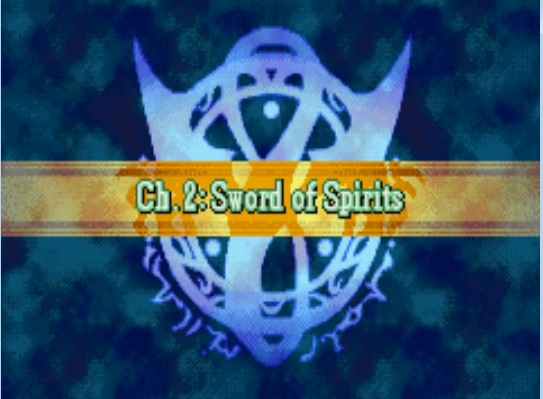
The War Room, Part 2
No big genius stuff here today, I'm just going to talk about the basic character stats in the game and what exactly they do. The exact formulas are good to understand for serious players.
SPOILERS: the boss of this chapter is Glass! Here in the war-room we're going to get a sneak preview of him and his stats for purposes of explaining them.

So here he is, the legendary swordsman. Just look at those stats and drool; they're so high the game flipped them back down to the single digits.
HP is fairly self-explanatory. When it runs out, you die. Almost everyone has something like 60% HP growth per level or better and it's not really worth much.
Str is a stat not every unit has. Mages and staff-users technically have Mag instead, but it's exactly the same. Honestly, I usually just call Mag Str. Anyway, Str is pretty simple. You add this to your weapon Might, subtract the enemy defense and terrain bonuses and any weapon triangle stuff and the enemy takes that much damage per hit from you
Skill is one of the less important stats. Your skill x2 is added to 1/2 your luck and your weapon accuracy to determine your base hit rate, but your weapon accuracy is typically so huge and the enemy dodge chance is so small that your skill barely matters past maybe 10 at best. 1/2 your Skill is also your base crit rate, but again that's not really that important. I mean, skill isn't useless, but you don't need much of it.
Speed- One stat to rule them all. You kill people with this. You tank with this. 2x your Speed is added to 1x your Luck to determine your base dodge rate. Furthermore, if this is higher than your enemy's by 4 or more, you'll get 2 attacks against them. So high speed doubles your damage output and it makes you dodge attacks. That said, it becomes less useful when you already have a ton of it, and you still need Strength to do any damage.
Luck- Ok, this one does a bunch of stuff. First of all, 1x your Luck is added to 2x your speed for your base dodge rate. Second, 1/2 your Luck is added to 2x your Skill and your weapon Accuracy to determine your base hit rate. Third, your luck is subtracted from the enemy base crit rate to determine their real crit rate.
Def is a seriously important stat, especially in HHM. Def is subtracted from the damage you would take from every single enemy attack with a non-magical weapon. Like 90% of enemies don't use magic, so Def is incredibly useful. One point of it is worth about 5 HP.
Res is Def but for magical attacks. Those are pretty rare and most enemy mages are easy prey so this stat isn't so important most of the time.
Move It's a bit more complicated than it sounds. This is how many squares your character can move over plains or the insides of buildings, but remember that different terrain affects different units in different ways. Most infantry (Mercenaries, fighters, archers, myrmidons), etc. are all in one category. Forests slow them by half speed, rivers and oceans are impassable, deserts hurt badly. Most mages are the same except that they can move full speed over deserts. Pirates are the same except they can move over rivers and oceans at half speed. Flyers move full speed everywhere except over walls, but flyers also cannot benefit from the defenses of terrain. Cavalry don't really have a pattern. Nomads move differently than cavaliers, cavaliers move differently than paladins, it's pretty crazy. Oh and lords move like infantry except they can go over rivers at very low speed. I repeat, Lords can cross rivers. That is hugely important later on. Know that. And experiment with different unit types on different terrain.
Con Now this one's a bit complicated. Every weapon has a Weight stat. If your currently equipped Weight is > your Con, the difference is taken as a penalty to your speed. This means you might not get 2 attacks vs enemies anymore and your chance of dodging attacks goes down. Avoid that when you can. Additionally, Con affects which allies you can rescue and carry around. For infantry, you can rescue anyone with Con lower than your own. Male cavalry/flyers can rescue anyone with Con lower than 25 - their own Con. Meaning the bigger you are, the less extra weight your horse can carry I suppose. Meanwhile female cavalry/flyers can rescue anyone with Con lower than 20 - their own Con. I'm... not sure why there's a difference between genders there. Do all women ride smaller animals all the time in this 'verse? Is it just for balance reasons so that Florina can't carry people with up to 20 Con even while promoted?
Anyway, your Con and Move only change when you promote. The other stats go up as you level up and as you promote. So a bad Con is a much more permanent handicap than a bad starting speed. Sucks to be you, pegasus knights!
Chapter Story Summary:
Lyn and her entourage make a side trip to a small temple to pray for a safe journey. After rescuing the priest and the Mani Katti- the sacred sword the temple is dedicated to- from some thugs, Lyn is shocked when the legendary sword chooses her to be its new bearer. This... actually has surprisingly little plot importance.
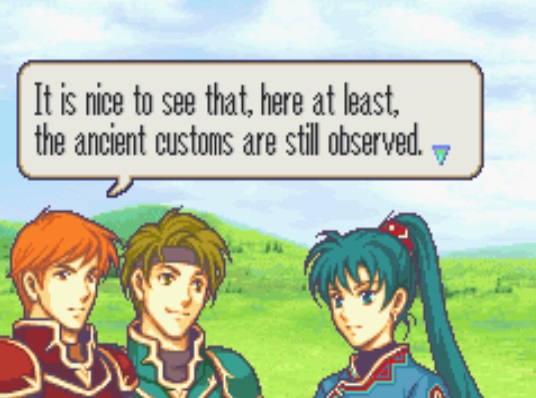
Although this chapter doesn't affect the plot much, it does build up the setting in interesting ways. See this legendary sword is a subject of purely local religious interest. In most places in Elibe (the world of this game), the religion venerating St. Elimine (One of the 8 legends who saved humankind from the dragons, but we know little else about her) is pre-eminent. Backwater, primitive Sacae seems to be the only place where this isn't the case. It also seems to be the place with the highest concentration of Shamans (users of dark or 'elder' magic) as evidenced particularly in FE6. This suggests an interesting relationship between the new religion of St. Elimine and the Light magic which seems to go with it and the old religious traditions and Dark or elder magic.
Perhaps Dark magic is dying out in the face of the new religion along with the old traditions. Lyn seems to have only vague, superstitious understandings of dark magic. Canas is the only dark mage available in the game and he insistently calls what he does "Elder" magic, stressing both that it's older than other forms of magic and that the common name "dark" may not be politically correct.
And in this game the two greatest and oldest dark mages of all time die, in part due to the actions of Lyn and her companions. There's something of an irony in the sword empowered by the ancient magics helping to sweep aside the greatest practitioners of the ancient magics, thereby speeding along the gradual extinction of the religion in which it was sacred.
I think this fits in with a broader theme in this game that the old must give way to the new and the torch must eventually be passed on to the next generation for there to be growth. Then again perhaps I'm reading too much into it.
Either way, it's something of a problem that this is pretty much the only time we even get hits about the religions of Elibe. This game could do with more information on the various cultures of its world. That FE6 tells us pretty much nothing at all doesn't help.

Heavy stuff aside, look at this idiot! One of my favorite bosses, he out-boasts just about everyone in the whole game while being completely worthless. Uh, don't tell him I said that. I wouldn't want him getting mad at me. No sir, I'm definitely Glass's biggest fan. Hardest boss in the whole game.
The Map:

Looks more complicated than it is. Basically I'm just going to take my time having Sain kill everything again. In this case that will require smashing through that cracked wall of the temple. "It became necessary to destroy the temple to save it." -Major Market
Notice those little houses in the bottom left corner? This map introduces houses which are basically squares where you can have your characters go to learn extra setting details or get some sometimes useful advice about how to proceed.
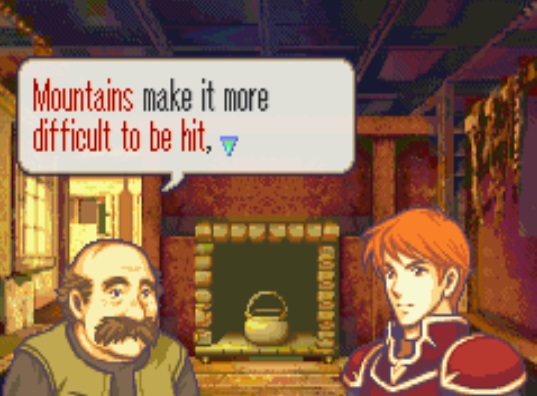
A lot of houses, especially in the tutorial, are full of out-of-character talk by metagaming villagers telling you to press the R button and so forth.
Honestly, I don't really like that. It breaks the suspension of disbelief and doesn't really fit with the seriousness of this game. One major problem this game has in general is that it isn't good at conveying the information you need to know to play it. The tutorial is all of Lyn's story, so that's 12 chapters long (alright, 9 because the last 3 don't really have much tutorial to them). And then it sort of continues into Eliwood/Hector's story. On chapter 16 they're still telling you stuff which by that point you've totally known for 10 levels. FE6 just had one optional training level in the game extras, which was too well hidden but was more concise at least.
8 and 9 and most of the later titles just had tutorial sections you could consult in the middle of the map, but those just provided written advice which wasn't as helpful as an actual tutorial level. All in all, i think a compromise should be found. A compromise that doesn't involve villagers telling me to press the R button or stand on mountains to avoid being hit, darn it!
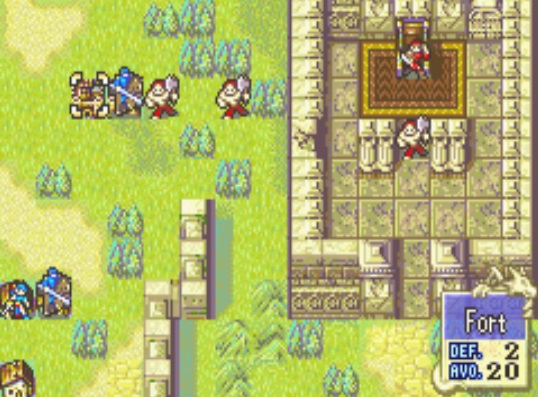
Speaking of mountains, let's talk terrain briefly. Basically terrain in this game has 2 effects. It can boost defense and it can slow movement. I mentioned in The War Room, Part 2, that the way terrain affects movement varies class by class in rather complicated ways. General rule: slower to move through = more powerful defensive terrain. Flying units go full speed through everything but walls, but terrain doesn't help them at all. Forests slow most people down moderately, they provide decent bonuses. Mountains slow people down a lot or are impassable, they provide big bonuses. Peaks are impassable for everyone but brigands (and flying units), they provide huge bonuses. Water just sucks though.
You can see the cursor here is on a Fort, which is one of the best common terrain types. It slows movement moderately, but as the lower right hand corner indicates it boosts your functional defense by 2 and your functional avoid by 20 if you stand on it. Not mentioned, it also heals you by 20% of your HP per turn. Good stuff because that healing is free, unlike vulneraries or heal staves, so it's pretty much the only kind of healing I'll be using during all of Lyn's story. Sain will use it to eat every enemy on this level while remaining unharmed.
The Characters:

"Who do you think you are? What chance to you have against me?? ?Glass, Chapter 2
The one, the only Glass. His swordplay is peerless! The gods fear his name! His resistance is so huge that Luna's effect does nothing to him! He's so strong that he can kill himself in one turn of attacking anyone on your team! He's so scary that the legendary Mani Katti hid in its scabbard at his approach and wouldn't come out! And with his psychic powers he controls not only the characters but the player! I don't think it's coincidence that 3 turns after he threatens to destroy the shrine of the Mani Katti, Sain suddenly tears down one of its walls. Truly, an adversary whose skill has never been equaled.
He kind of comes out of nowhere and there isn't much explanation of who he is other than this arrogant guy who wants to use the Mani Katti and has some minions. Every boss from here on out has a real purpose though.
Playing Through:

As I mentioned, Sain will wait on the fort for all the nearby enemies. The added defense and healing every turn lets him use his lance with impunity instead of his more expensive but accurate sword.
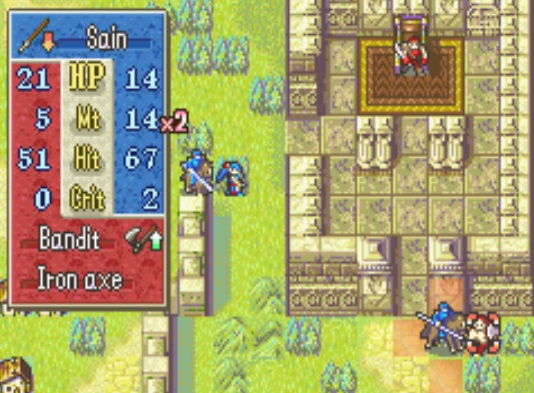
This one guy doesn't come to you, so you have to tear down the wall and go to him. Heeeeeee'res Johhny!
Again, I use terrain bonuses from the forest to let Sain get away with cheaply using his lance instead of his sword.
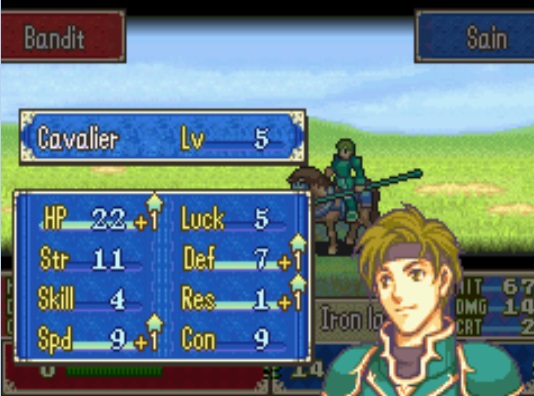
Sain? You and I are going to accomplish wonderful things.
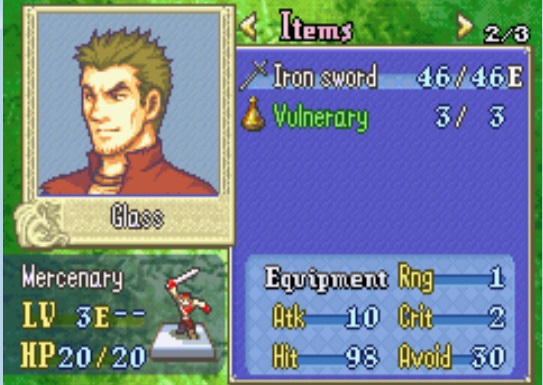
The fight with Glass is borderline un-losable under any circumstances. See how his Vulnerary is green? That means he'll drop it when he dies. Those things are worth 300 gold each, and getting every single one of them available is critical to managing to get 32,000+ gold in assets while using the Knight Crest and Angelic Robe, which is my plan.
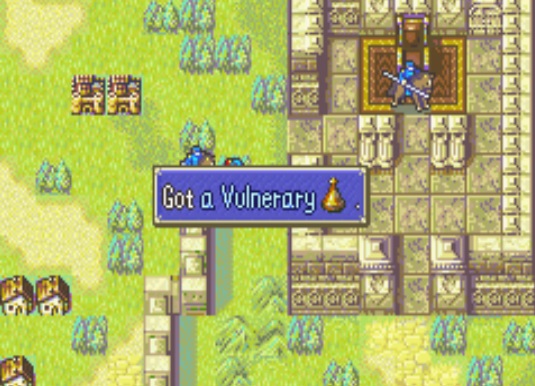
Yep, there's that vulnerary.
Victory! We have victoryyyyyyyy!
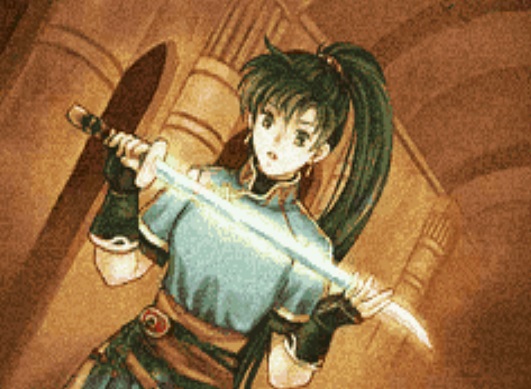
So Lyn rescues the priest and he lets her touch the Mani Katti, which promptly lights up and lets her draw it. It has chosen her as its bearer.
?It is time for you to go, Lyn. You face a great many ordeals. Grip this sword and meet your destiny head-on.? ?Priest of the Mani Katti Shrine, Chapter 2
Sain subsequently proves once again that he's actually pretty smart by providing the best explanation to Lyn of what it means for the sword to have chosen her. She's still appropriately awestruck by having been chosen.
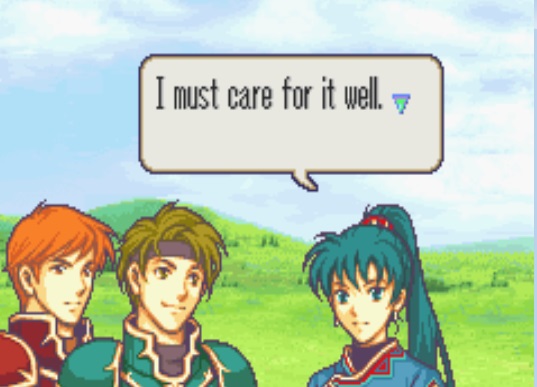
And, you know, she mentions that she needs to take care of this new amazing sword. I appreciate this kind of realistic detail; the recognition that weapons need to be cared for and maintained, animals need to be fed and can get sick, etc. In my opinion, little details like those popping up here and there really help make this Fire Emblem seem less cartoonish and more gritty and interesting than some of the others.
And Now For Something Completely Different!
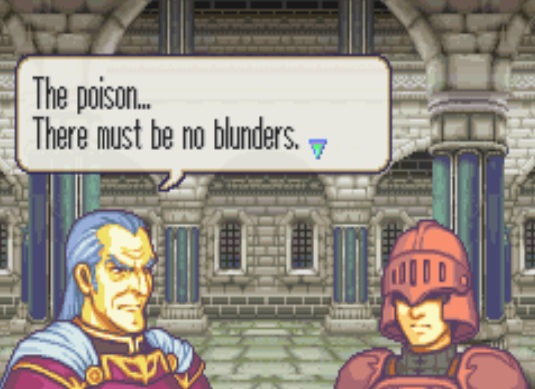
One trope common to nearly all FE games is the enemy scheme cutscene. Here the action suddenly zooms 400 miles away to Caelin where Lundgren is informed Lyn survived his first assassination attempt and is now with Sain and Kent. Lundgren decides that that doesn't really matter since she'll surely get killed by bandits living in the lawless border area she has to cross to get to Caelin. And it's revealed that he has now decided to just cut out the middleman and kill his brother with poison in secret rather than wait for the guy to die. Secret is the keyword here, they want it to look like a slow, wasting illness and want to make sure that the Marquess himself doesn't suspect the truth. So the guy will still be around for quite a few more chapters, just increasingly bedridden.
I'm not entirely sure what I think of the whole enemy scheme cutscene as a storytelling device.
On one hand, it makes absolutely no sense. How do we know about this top secret conversation? There's surely a more organic way to reveal this kind of information.
On the other hand, there's probably no better way to elaborate on the personalities of the various villains than to show how they deal with one another and their henchmen. It's that kind of nuance and detail that makes them into people rather than blocks of stats. A lack of this kind of detail hurts FE9 in particular where toward the end of the game you fight something like 6 generals of Daein who have no personality or history or background or anything really.
Also? I want to look like Lundgren when I'm old.
So that's chapter 2. All in all, I think it's one of the low points of the game. Too simple and too easy with nothing new added gameplay wise and little consequence to the story. The first time I played it it was quite exiting though. Wow! The Mani Katti! Wow, Lyn is going to be its bearer! She must be important! Big things are going to happen to her! But... no. No, Lyn is a fun and interesting side story and a good supporting character, but that's all. She doesn't seem to be destined for anything special in the end, she just moves back home to Sacae or marries Eliwood or something. That's a shame, I think she's one of the better done female protagonists I've seen in a videogame and I wish she could do something of consequence in the end other than marry one of the leading men.
And why did the Mani Katti choose her? It's not like it's specially useful in the seriously big stuff she gets involved in the periphery of. If anything, it seems like it says more about Lyn that one of the Heaven Seals chooses her than that the Mani Katti does. Perhaps the main function of this chapter is to set up for more important weapons choosing their bearers later on?
Things are looking up next chapter though!















